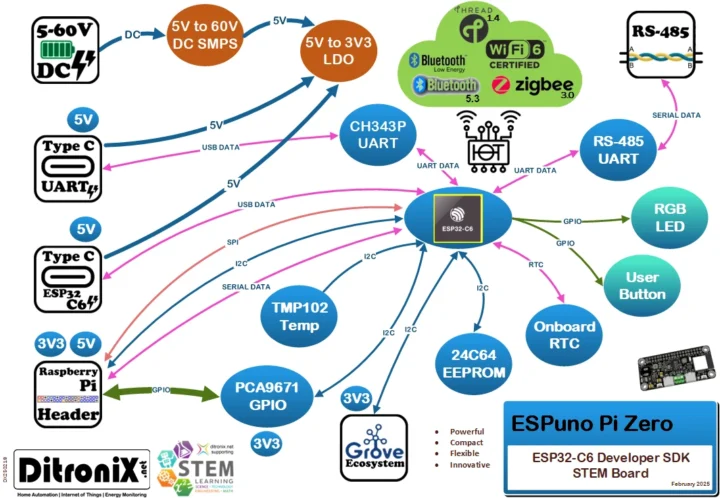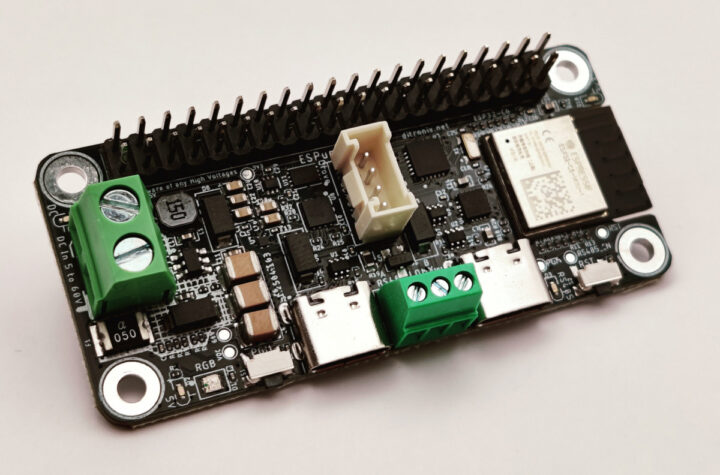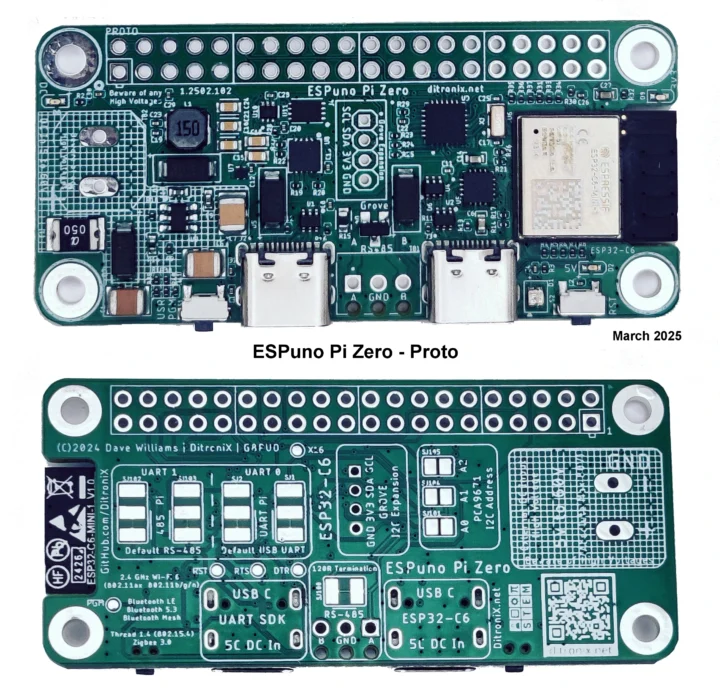ESPuno Pi Zero is a Raspberry Pi Zero-sized board based on an ESP32-C6-MINI-1 WiFI 6, BLE, and 802.15.4 wireless module and an SMPS that allows up to 60V DC input via a 2-pin terminal block.
The board also features two USB-C ports, one connected to the ESP32-C6 and the other to a CH343P USB-to-serial chip, a 40-pin GPIO header, a Grove connector, a 3-pin terminal block for RS-485, DMX, Profibus, and a few buttons and LEDs.
ESPuno Pi Zero specifications:
- ESP32-C6-MINI-1-N4 or ESP32-C6-MINI-1U-N4
- SoC – Espressif Systems ESP32-C6 single-core 32-bit RISC-V clocked up to 160 MHz 320KB ROM, 512KB SRAM, low-power RISC-V core @ up to 20 MHz
- CPU
- Single-core 32-bit RISC-V clocked up to 160 MHz
- Low-power RISC-V core @ up to 20 MHz
- Memory/Storage – 320KB ROM, 512KB SRAM
- Wireless – 2.4 GHz WiFi 6, Bluetooth 5.0, and 802.15.4 radio (for Thread/Zigbee)
- CPU
- Storage – 4MB flash
- Antenna
- ESP32-C6-MINI-1-N4 – PCB antenna
- ESP32-C6-MINI-1U-N4 – External antenna
- SoC – Espressif Systems ESP32-C6 single-core 32-bit RISC-V clocked up to 160 MHz 320KB ROM, 512KB SRAM, low-power RISC-V core @ up to 20 MHz
- Storage – 64Kbit 24C64 I2C EEPROM
- USB
- 1x USB Type-C UART (CH343P) port
- 1x USB Type-C port connected to ESP32-C6
- Expansion
- 40-pin Raspberry Pi-compatible GPIO header via PCA9671 GPIO extender
- 4-pin Grove I2C connector
- 3-pin RS-485 terminal block with support for the DMX512 lighting standard, Modbus, and Profibus
- Misc
- On-board RTC
- Reset and User buttons
- Power LEDs, RGB LED
- Power Supply
- 5V via either USB-C ports
- 5 to 60V DC via 2-pin terminal block for batteries or solar panels
- 5V SMPS 600mA
- 3V3 LDO 700mA
- Dimensions – 65 x 30mm (Raspberry Pi Zero form factor)

DitroniX (Dave Williams) says the board can be programmed with Arduino, CircuitPython, the ESP-IDF framework, PlatformIO, Tasmota, ESPHome, etc… basically the full list of languages, frameworks, and firmware supported by the ESP32-C6. The GitHub repository for the project currently has a few component datasheets, a description of the board, and a code directory with a holder structure for GPIO, Home Automation, RS485, Grove, and radios, but no actual samples just yet.
The board is designed for STEM education for RS485, DMX/DMX512 lighting systems, Modbus RTU control, solar energy monitoring, robotics, drones, and industrial applications. I felt like I had already written about an ESP32 board with 60V DC input, and indeed, the Voidbox FLIP_C3 based on an ESP32-C3 WiFi and BLE module does support up to a 6V to 60V (peak) input range. The ESPuno Pi Zero has a larger design with support for more features and a more powerful ESP32-C6 wireless SoC.
Dave has launched the ESPuno Pi Zero on Kickstarter with a £1000 funding target. Pledges start at £19 (About $26) for the early bird reward with a PCB antenna, and £24 (about $32) with an external antenna. There are also bundles of 5 boards to get better pricing per unit. Shipping adds £4 to the UK and around $5.3 to the rest of the world. Deliveries are scheduled to start in May 2025, right after the crowdfunding campaign ends.

Jean-Luc started CNX Software in 2010 as a part-time endeavor, before quitting his job as a software engineering manager, and starting to write daily news, and reviews full time later in 2011.
Support CNX Software! Donate via cryptocurrencies, become a Patron on Patreon, or purchase goods on Amazon or Aliexpress







